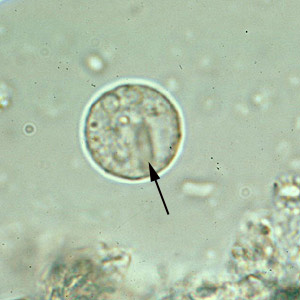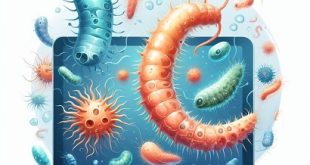انتامبا هیستولیتیکا یک انگل تک یاخته ای است که باعث آمیبیاز می شود، بیماری که میلیون ها نفر را در سراسر جهان تحت تاثیر قرار می دهد. آمیبیاز می تواند به صورت اسهال خونی، آبسه کبد یا سایر عوارض خارج روده ای ظاهر شود. در این مطلب مورفولوژی انتامبا هیستولیتیکا را بررسی خواهیم کرد و اسلاید های مربوط به این موضوع را ارایه خواهیم داد.
مورفولوژی انتامبا هیستولیتیکا
انتامبا هیستولیتیکا به دو شکل وجود دارد: تروفوزوئیت و کیست. تروفوزوئیت شکل فعال و تهاجمی است، در حالی که کیست شکل خفته و عفونی است.
تروفوزوئیت
تروفوزوئیت مرحله تغذیه و تقسیم انگل است. در روده بزرگ میزبان یافت می شود، جایی که به پوشش مخاطی می چسبد و باعث آسیب بافتی می شود. تروفوزوئیت دارای ویژگی های زیر است:
- شکل: نامنظم و متغیر است، بسته به موقعیت کاذب پا (پاهای کاذب) که به حرکت و خوردن غذا کمک می کند.
- اندازه: از ۱۸ تا ۴۰ میکرومتر با میانگین ۲۰ تا ۳۰ میکرومتر متغیر است. .(در بعضی منابع تا ۶۰ میکرون گزارش شده)
- سیتوپلاسم: به دو قسمت اکتوپلاسم شفاف و آندوپلاسم دانه ای تقسیم می شود. آندوپلاسم حاوی گلبول های قرمز بلعیده شده، ذرات غذا و واکوئل است.
- هسته: منفرد، کروی و در مرکز قرار دارد. دارای یک کاریوزوم مرکزی (توده کروماتین) و کروماتین محیطی ظریف (DNA و پروتئین) است. هسته دارای ظاهر مشخصه “چرخ درشکه” است.

کیست
کیست مرحله استراحت و مقاوم انگل است. هنگامی که تروفوزوئیت با شرایط نامساعدی مانند کم آبی، pH پایین یا اسمولاریته بالا مواجه می شود، تشکیل می شود. کیست از طریق مدفوع میزبان خارج می شود و می تواند هفته ها در محیط زنده بماند. کیست دارای ویژگی های زیر است:
- شکل: گرد یا بیضی، با دیواره ای صاف و ضخیم است.
- اندازه: از ۱۰ تا ۲۰ میکرومتر با میانگین ۱۲ تا ۱۵ میکرومتر متغیر است.
- سیتوپلاسم: شامل چهار هسته است که هر یک دارای کاریوزوم کوچک و کروماتین محیطی درشت هستند. همچنین حاوی میله های کروماتوئیدی (توده های میله ای شکل RNA) و توده های گلیکوژن (ذخایر انرژی) است.
لینک دانلود اسلایدها
پیشنهاد می کنیم جهت بدست آوردن اطلاعات بیشتر درمورد این انگل پست های زیر را مطالعه کنید:
Entamoeba histolytica morphology
Entamoeba histolytica is a protozoan parasite that causes amoebiasis, a disease that affects millions of people worldwide. Amoebiasis can manifest as dysentery, liver abscess, or other extraintestinal complications. In this article, we will explore the morphology of Entamoeba histolytica.
Morphology of Entamoeba histolytica
Entamoeba histolytica exists in two forms: the trophozoite and the cyst. The trophozoite is the active and invasive form, while the cyst is the dormant and infective form.
Trophozoite
The trophozoite is the feeding and dividing stage of the parasite. It is found in the large intestine of the host, where it adheres to the mucosal lining and causes tissue damage. The trophozoite has the following characteristics:
- Shape: It is irregular and variable, depending on the position of the pseudopodia (false feet) that help it move and ingest food.
- Size: It ranges from 18 to 40 micrometers, with an average of 20 to 30 micrometers.
- Cytoplasm: It is divided into two parts: the clear ectoplasm and the granular endoplasm. The endoplasm contains ingested red blood cells, food particles, and vacuoles.
- Nucleus: It is single, spherical, and centrally located. It has a central karyosome (mass of chromatin) and fine peripheral chromatin (DNA and protein). The nucleus has a characteristic “cartwheel” appearance.
Cyst
The cyst is the resting and resistant stage of the parasite. It is formed when the trophozoite encounters unfavorable conditions, such as dehydration, low pH, or high osmolarity. The cyst is passed out in the feces of the host and can survive for weeks in the environment. The cyst has the following characteristics:
- Shape: It is round or oval, with a smooth and thick wall.
- Size: It ranges from 10 to 20 micrometers, with an average of 12 to 15 micrometers.
- Cytoplasm: It contains four nuclei, each with a small karyosome and coarse peripheral chromatin. It also contains chromatoidal bars (rod-shaped masses of RNA) and glycogen masses (energy reserves).
 انگل شناسی پزشکی Medical Parasitology
انگل شناسی پزشکی Medical Parasitology





